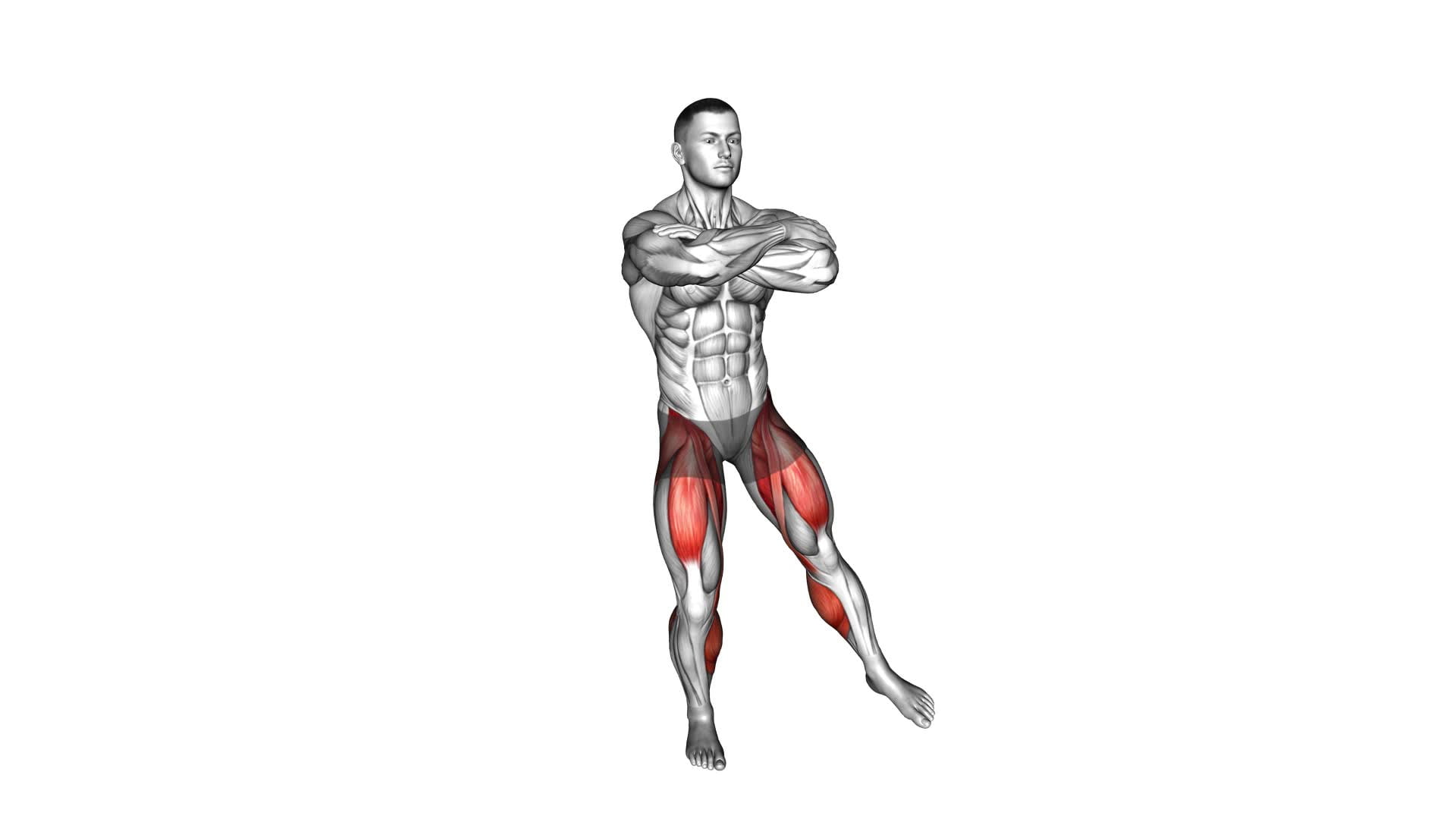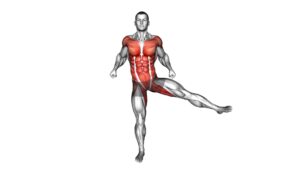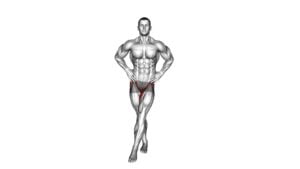Hopping Pendulum (male) – Video Exercise Guide & Tips

If you're looking for an effective lower body exercise, the Hopping Pendulum is a must-try. This video exercise guide and tips will show you the proper form and technique to maximize your results.
Watch This Exercise Video
With variations and progressions to challenge yourself, you'll strengthen your legs and improve your balance.
Avoid common mistakes and follow these evidence-based tips for a safe and effective workout.
Get ready to hop your way to stronger legs!
Key Takeaways
- The hopping pendulum exercise improves balance, coordination, and cardiovascular fitness.
- Proper form and technique are important to avoid excessive momentum and reduce joint impact.
- Modifications can be made for individuals with knee or ankle issues.
- Variations and progressions, such as using support or adding resistance, can increase the challenge of the exercise.
Benefits of the Hopping Pendulum Exercise
To understand the benefits of the Hopping Pendulum Exercise, you need to know how it can improve your balance and coordination. This exercise is a great way to enhance your overall balance by challenging your stability and coordination skills. By hopping from one foot to the other while swinging your arms in a pendulum-like motion, you engage multiple muscles in your legs, core, and upper body. This movement requires you to maintain control and stability, which helps improve your balance over time.
Additionally, the Hopping Pendulum Exercise is an effective cardiovascular conditioning exercise. The continuous hopping motion elevates your heart rate, making it a great option for improving your cardiovascular fitness. Regularly incorporating this exercise into your fitness routine can enhance your endurance and stamina.
Research has shown that improved balance and cardiovascular conditioning can have numerous benefits for your overall health and well-being. Better balance can reduce the risk of falls and injuries, especially as you age. It can also enhance your performance in sports and other physical activities. Improved cardiovascular conditioning, on the other hand, can lower the risk of heart disease, strengthen your heart and lungs, and boost your energy levels.
Proper Form and Technique
Maintain proper form and technique while performing the Hopping Pendulum Exercise to maximize its benefits and avoid injury. To ensure you're performing the exercise correctly, it's important to be aware of common mistakes and injury modifications.
One common mistake to watch out for is using excessive momentum. It's crucial that you control the movement and avoid swinging your body too forcefully. By maintaining control, you'll engage the targeted muscles more effectively and reduce the risk of strain or injury.
Another mistake to avoid is landing with a locked knee. When you land after hopping, make sure to slightly bend your knee to absorb the impact. This will help to protect your joints and prevent unnecessary stress.
If you have any knee or ankle issues, it's important to modify the exercise to avoid exacerbating these conditions. You can perform the exercise on a softer surface, such as a mat or grass, to reduce the impact on your joints. Additionally, you can decrease the height of the hop to minimize stress on your knees and ankles.
Variations and Progressions
Now let's talk about some variations and progressions you can incorporate into your hopping pendulum exercise.
If you're a beginner, you can start by modifying the intensity and range of motion to suit your fitness level.
For those looking for a challenge, advanced techniques like adding weight or increasing the speed can take your workout to the next level.
Additionally, if you have any injuries or limitations, it's important to modify the exercise to ensure safety and prevent further damage.
Beginner Modifications
Start with simpler variations and progressions to make the Hopping Pendulum exercise more accessible for beginners. Here are three modifications that can help accommodate different fitness levels and injuries:
- Reduced range of motion: Limit the height of the hop to reduce stress on the joints, especially if you have knee or ankle issues. This modification allows you to still engage the muscles without putting excessive strain on vulnerable areas.
- Decreased speed: Slow down the tempo of the exercise to focus on control and stability. This variation is beneficial for beginners who may struggle with balance or coordination, allowing them to build strength and confidence gradually.
- Use of support: Hold onto a stable surface, such as a chair or wall, to assist with balance and stability. This modification is particularly helpful for individuals with balance impairments or those recovering from injuries.
Advanced Techniques
Explore challenging variations and progressions to take your Hopping Pendulum exercise to the next level.
Incorporating advanced modifications and training techniques will help you further enhance your strength, stability, and coordination.
One advanced modification you can try is the Single Leg Hopping Pendulum. Instead of using both legs to hop, focus on one leg at a time. This variation increases the demand on your balance and activates the stabilizing muscles in your standing leg.
Another advanced technique is to add resistance by holding a dumbbell or kettlebell in your hands while performing the exercise. This adds an extra challenge to your upper body and core muscles. Remember to start with lighter weights and gradually increase as you become more comfortable.
Push yourself, but always listen to your body and maintain proper form to prevent injury.
Modifying for Injuries
To modify the Hopping Pendulum exercise for injuries, you can incorporate variations and progressions that cater to your specific needs. Modifying exercises is crucial for preventing further injury and ensuring a safe and effective workout. Here are three variations and progressions to consider:
- Decrease the range of motion: Limit the height of your jumps to reduce impact on your joints.
- Use a support: Hold onto a stable object, such as a chair or wall, to provide stability and balance while performing the exercise.
- Slow down the movement: Perform the exercise at a slower pace to minimize stress on your muscles and joints.
By modifying the Hopping Pendulum exercise, you can continue to work out while minimizing the risk of aggravating your injury.
Now, let's explore some common mistakes to avoid when performing this exercise.
Common Mistakes to Avoid
Avoid these common mistakes when performing the hopping pendulum exercise. To ensure you get the most out of this exercise and minimize the risk of injury, it's important to be aware of these common errors.
First, one common mistake is using too much momentum. When performing the hopping pendulum exercise, it's crucial to focus on controlled movements. Avoid swinging your legs too forcefully or relying on momentum to complete the exercise. Instead, engage your core and use the muscles in your legs to generate the movement.
Another mistake to avoid is improper landing technique. When hopping from one leg to the other, make sure to land softly and with control. Avoid landing with a straight leg, as this puts excessive stress on your joints. Instead, aim to land with a slight bend in your knee and absorb the impact through your muscles.
Lastly, be mindful of your posture throughout the exercise. It's common for people to round their shoulders or hunch forward when performing the hopping pendulum. To maintain proper form, keep your chest lifted, shoulders back, and engage your core muscles.
Tips for a Safe and Effective Workout
To ensure a safe and effective workout, incorporate proper form and utilize the appropriate amount of resistance. Proper form is crucial to prevent injuries and maximize the effectiveness of your exercises. Pay attention to your body alignment, maintain a neutral spine, and engage the correct muscles for each movement. Using the right amount of resistance is also important. Too little resistance may not challenge your muscles enough, while too much resistance can lead to strain or injury. Gradually increase the resistance as you get stronger and more comfortable with the exercises.
In addition to form and resistance, there are other factors to consider for a safe and effective workout. Here are three tips to help you:
- Use the right workout equipment: Ensure that you have the proper equipment for your exercises. This includes wearing appropriate shoes, using the right weights or resistance bands, and checking the condition of your equipment regularly to avoid any accidents.
- Warm up exercises: Prioritize warming up your body before diving into your workout routine. Engage in dynamic stretches and light cardio exercises to increase blood flow, warm up your muscles, and prepare your body for the upcoming workout.
- Listen to your body: Pay attention to any pain or discomfort during your workout. If something doesn't feel right, stop and assess the situation. Pushing through pain can lead to injuries. Modify or adjust the exercise as needed to ensure your safety.
Sample Hopping Pendulum Workout Routine
To get the most out of your hopping pendulum workout, it's important to find the optimal repetition count that challenges your muscles without sacrificing form. Start with a lower repetition count, such as 8-10 reps per set, and gradually increase as you build strength and endurance.
For beginners, variations like the single-leg hopping pendulum or using a support for balance can help ease into the exercise and prevent injury.
Optimal Repetition Count
Maximize your workout effectiveness with the optimal repetition count for the sample Hopping Pendulum workout routine.
The repetition range for the Hopping Pendulum exercise is typically between 10 to 15 repetitions per set. This range allows for sufficient muscle activation and endurance development while avoiding overexertion.
Here are three reasons why the optimal repetition count is crucial for your workout:
- Muscle Growth: Performing the Hopping Pendulum within the recommended repetition range stimulates muscle growth and hypertrophy, leading to increased strength and definition.
- Endurance Improvement: By performing a higher number of repetitions, you challenge your muscles to adapt and improve their endurance capacity, enhancing your overall fitness level.
- Injury Prevention: Sticking to the optimal repetition count ensures that you maintain proper form throughout the exercise, reducing the risk of injury and promoting safe and effective training.
Variations for Beginners
You can modify the Hopping Pendulum exercise to suit beginners with these variations.
For beginners, it's important to start with simpler modifications that focus on building stability and coordination.
One way to modify the exercise is to reduce the range of motion. Instead of hopping from side to side, beginners can start by just lifting one foot off the ground and tapping it to the side.
Another modification is to slow down the movement. Beginners can hop at a slower pace, allowing them to focus on maintaining balance and control.
As beginners progress and become more comfortable with the exercise, they can gradually increase the range of motion and speed to challenge themselves.
These modifications serve as a foundation for more advanced progressions in the Hopping Pendulum exercise.
Frequently Asked Questions
How Many Calories Can I Burn by Doing the Hopping Pendulum Exercise?
By incorporating the hopping pendulum exercise into your fitness routine, you can experience a range of benefits.
This exercise not only helps to improve balance and coordination but also works your lower body muscles, including the glutes, quads, and calves.
To maximize calorie burn, try incorporating variations of the hopping pendulum exercise, such as adding weights or increasing the speed and intensity.
These variations will challenge your muscles and increase the overall calorie burn during your workout.
Can the Hopping Pendulum Exercise Help Improve My Balance and Coordination?
Improving stability and coordination are important for overall fitness.
Dynamic movements, like the hopping pendulum exercise, can help you achieve these goals.
By challenging your balance and coordination, this exercise forces your muscles to work together in a coordinated manner.
This can lead to improved stability and better overall movement control.
Adding the hopping pendulum exercise to your routine can provide additional benefits beyond just calorie burning.
What Muscles Does the Hopping Pendulum Exercise Target?
The hopping pendulum exercise targets multiple muscles in your body. It primarily works your leg muscles, including your quadriceps, hamstrings, and calves. Additionally, it engages your glutes, core muscles, and stabilizer muscles in your hips and ankles.
Can I Modify the Hopping Pendulum Exercise if I Have Knee or Ankle Issues?
If you have knee or ankle issues, there are modifications you can make to the hopping pendulum exercise. Instead of hopping, you can try doing a modified version that involves stepping side to side or front to back. This will reduce the impact on your joints while still targeting the same muscles.
Alternatively, you can try other exercises that focus on strengthening the same muscle groups, such as lunges or step-ups.
Remember to listen to your body and choose exercises that are comfortable for you.
Is It Necessary to Warm up Before Performing the Hopping Pendulum Exercise?
Before performing the hopping pendulum exercise, it's necessary to warm up.
Warming up has several benefits, such as increasing blood flow to your muscles and preparing your body for the exercise ahead.
To properly warm up, you can start with some light cardio exercises like jogging or jumping jacks to get your heart rate up.
Then, you can do dynamic stretches to loosen up your muscles and improve flexibility.
Conclusion
In conclusion, the hopping pendulum exercise is a beneficial and effective workout for improving lower body strength, balance, and coordination.
By following proper form and technique, avoiding common mistakes, and progressing through variations, you can maximize the benefits of this exercise.
Remember to prioritize safety and listen to your body during your workout.
Incorporating the hopping pendulum exercise into your routine can help you achieve your fitness goals and enhance your overall physical performance.

Author
Years ago, the spark of my life’s passion ignited in my mind the moment I stepped into the local gym for the first time. The inaugural bead of perspiration, the initial endeavor, the very first surge of endorphins, and a sense of pride that washed over me post-workout marked the beginning of my deep-seated interest in strength sports, fitness, and sports nutrition. This very curiosity blossomed rapidly into a profound fascination, propelling me to earn a Master’s degree in Physical Education from the Academy of Physical Education in Krakow, followed by a Sports Manager diploma from the Jagiellonian University. My journey of growth led me to gain more specialized qualifications, such as being a certified personal trainer with a focus on sports dietetics, a lifeguard, and an instructor for wellness and corrective gymnastics. Theoretical knowledge paired seamlessly with practical experience, reinforcing my belief that the transformation of individuals under my guidance was also a reflection of my personal growth. This belief holds true even today. Each day, I strive to push the boundaries and explore new realms. These realms gently elevate me to greater heights. The unique combination of passion for my field and the continuous quest for growth fuels my drive to break new ground.



